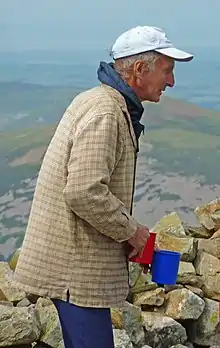Joss Naylor
Joss Naylor, MBE (born 10 February 1936 at Wasdale Head) is an English fell runner who set many long-distance records, and a sheep farmer, living in the English Lake District. As his achievements increased he became better known as the King of the Fells or simply the Iron Man.
 Joss Naylor providing water to fell runners - Ennerdale Horseshoe Fell Race June 2010 | |
| Personal information | |
|---|---|
| Nationality | British |
| Born | February 10, 1936 Wasdale Head |
| Occupation | Farmer |
| Sport | |
| Sport | Fell Running |
| Updated on 4 November 2013. | |
Biography
Naylor[1] was born in 1936 in Middle Row Farm, Wasdale Head, and attended school in Gosforth, leaving at 15 to work on the family farm. Injuries in his youth led to operations aged 19 to remove cartilage from his right knee and aged 22 to remove two disks from his back. He took up running in 1960 aged 24, winning his first race, the Mountain Trial, in 1966. In 1971, he completed the Bob Graham Round, only the sixth person to do so, and continued to win races and set records through the 1970s and 1980s. In 1978, following medical advice that his back was deteriorating, he reduced his farming activities (selling his cattle but retaining his sheep), and took a job training apprentices at Windscale. In his seventies, he started spending winters in Spain, as cold weather caused circulation problems in his legs.[2]
He married Mary in 1963. Their son, Paul, has now taken over the farm.
Fell-running achievements
His fell running achievements include successive peak bagging records within the scope of the Bob Graham Round:[3]
- 1971: 61 peaks in 23h37m
- 1972: 63 peaks in 23h35m
- 1975: 72 peaks, claimed to involve over 100 miles and about 38,000 feet of ascent in 23h20m (record stood until 1988)
His other fell running achievements include:
- 1971: The National Three Peaks Challenge (Ben Nevis, Scafell Pike and Snowdon): 11 hours 54 minutes including driving time
- 1973: The Welsh 3000s - the 14 peaks of Snowdonia in 4 hours 46 minutes (record stood until 1988)
- 1974: The Pennine Way: 3 days, 4 hours, 36 minutes (record stood until 1989)
- 1976: Robin Hood Bay to St Bees: 41 hours
- 1979: The Lyke Wake Walk: 4 hours 53 minutes (set during the annual race)[4] (record stood until 1981)
- 1983: The Lakes, Meres and Waters circuit of 105 miles: 19 hours 20 minutes
- 1986: (age 50) completed the Wainwrights in 7 days, 1 hour, 25 minutes[5] (record stood until 2014)
- 1997: (age 60) ran 60 Lakeland fell tops in 36 hours
- 2006: (age 70) ran 70 Lakeland fell tops, covering more than 50 miles and ascending more than 25,000 feet, in under 21 hours.
Legacy
He considered the 72 peak Lakeland circuit as his own greatest achievement, setting a record which stood unbroken for 13 years. He was appointed an MBE[6] for his services to sport and charity, and is included as one of Britain’s top 100 sports personalities in the 2007 book Best of British: Hendo’s Sporting Heroes, by sports journalist Jon Henderson.[7] Olympic Gold medal winner and co-founder of the London Marathon Chris Brasher described Joss Naylor as 'The Greatest of Them All', a title he bestowed on Joss when he ran 72 Lake District mountains in 24 hours.[8]
Naylor completed some of his achievements in extreme weather conditions (the 1972 63 peaks record in a severe storm, and the 1975 72 peaks record and large sections of the 1986 Wainwrights record in a heat wave), and he is noted for his ability to persevere despite pain and adversity. He is also noted for his humility and his generosity towards less talented runners, and in keeping with British fell-running traditions, he has frequently provided support or pacing for other runners attempting the same or similar challenges. However, on occasion he has been less enthusiastic about runners who differ from his approach by setting records only in optimum conditions or who use more scientific methods such as use of spreadsheets for planning attempts.[1]
He created his own fell-running challenge, the Joss Naylor Lakeland Challenge, open to over-fifties only. This runs 48 miles (77 km) from Pooley Bridge to Greendale Bridge, traversing 30 summits, with climbing of 17,000 feet (5182 m).[9]
Naylor is the subject of a biography by Keith Richardson,[10] and his fell running exploits are covered in detail in Steve Chilton's It's a hill, get over it: fell running's history and characters[11] and in Richard Askwith's Feet in the Clouds.[1]
See also
- Bill Smith (fell runner)
- Billy Bland (runner)
- British orienteers
- List of orienteers
- List of orienteering events
- Munro/ "Munro Bagging"
References
- Askwith, Richard (2004). Feet in the Clouds: A Tale of Fell-running and Obsession. London: Arum Press Ltd. ISBN 978 1 84513 649 9.
- Greenbank, Tony (22 December 2014). "Cumbria's iron man". The Guardian. Retrieved 17 September 2019.
- Covell, Brian; Griffin, A.H.; Smith, Roger (1992) [1982]. 42 Peaks: The Story of the Bob Graham Round. The Bob Graham Club.
- "Lyke Wake Shield fastest time" (PDF). Lyke Wake Walk. Retrieved 16 September 2019.
- Naylor, Joss. Joss Naylor MBE was here. Braithwaite: KLETS.
- "No. 46919". The London Gazette (Supplement). 4 June 1976. p. 8029.
- Best of British: Hendo's Sporting Heroes, Jon Henderson (Yellow Jersey Press) 2007, ISBN 0-224-08248-5
- Keith Richardson, Joss (Keswick, 2009).
- "Joss Naylor Lakeland Challenge". jossnaylor.blogspot.com. Retrieved 2019-09-17.
- Keith Richardson, Joss (Keswick, 2009)
- Chilton, Steve (2013). It's a hill, get over it: fell running's history and characters. Dingwall: Sandstone Press. ISBN 978-1-908737-57-1.